|
|
|
Sort Order |
|
|
|
Items / Page
|
|
|
|
|
|
|
| Srl | Item |
| 1 |
ID:
101225
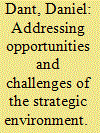

|
|
|
| 2 |
ID:
069997
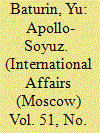

|
|
|
| 3 |
ID:
127515
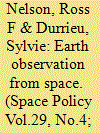

|
|
|
|
|
| Publication |
2013.
|
| Summary/Abstract |
Remote sensing scientists work under assumptions that should not be taken for granted and should, therefore, be challenged. These assumptions include the following:
1. Space, especially Low Earth Orbit (LEO), will always be available to governmental and commercial space entities that launch Earth remote sensing missions.
2. Space launches are benign with respect to environmental impacts.
3. Minimization of Type 1 error, which provides increased confidence in the experimental outcome, is the best way to assess the significance of environmental change.
4. Large-area remote sensing investigations, i.e. national, continental, global studies, are best done from space.
5. National space missions should trump international, cooperative space missions to ensure national control and distribution of the data products.
At best, all of these points are arguable, and in some cases, they're wrong. Development of observational space systems that are compatible with sustainability principles should be a primary concern when Earth remote sensing space systems are envisioned, designed, and launched. The discussion is based on the hypothesis that reducing the environmental impacts of the data acquisition step, which is at the very beginning of the information stream leading to decision and action, will enhance coherence in the information stream and strengthen the capacity of measurement processes to meet their stated functional goal, i.e. sustainable management of Earth resources. We suggest that unconventional points of view should be adopted and when appropriate, remedial measures considered that could help to reduce the environmental footprint of space remote sensing and of Earth observation and monitoring systems in general. This article discusses these five assumptions in the context of sustainable management of Earth's resources. Taking each assumption in turn, we find the following:
(1) Space debris may limit access to Low Earth Orbit over the next decades.
(2) Relatively speaking, given that they're rare event, space launches may be benign, but study is merited on upper stratospheric and exospheric layers given the chemical activity associated with rocket combustion by-products.
(3) Minimization of Type II error should be considered in situations where minimization of Type I error greatly hampers or precludes our ability to correct the environmental condition being studied.
(4) In certain situations, airborne collects may be less expensive and more environmentally benign, and comparative studies should be done to determine which path is wisest.
(5) International cooperation and data sharing will reduce instrument and launch costs and mission redundancy. Given fiscal concerns of most of the major space agencies - e.g. NASA, ESA, CNES - it seems prudent to combine resources.
|
|
|
|
|
|
|
|
|
|
|
|
|
|
|
|
| 4 |
ID:
133501
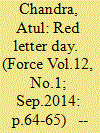

|
|
|
|
|
| Publication |
2014.
|
| Summary/Abstract |
The Indian Space Research Organisation's (ISRO) Mars Orbiter Mission (MOM) spacecraft concludes its incredible 680 million km journey this month, which began when the Mars Obiter was launched from the Satish Dhawan Space Centre (SHAR) at Sriharikota in November last year.
In a post on its Facebook page, in the last week of August, ISRO announced that its Mars Orbiter Mission spacecraft was just 9 million km away from Mars. ISRO scientists have already begun preparations for the moment of truth for the mission; when the spacecraft is released into Mars Orbit.
|
|
|
|
|
|
|
|
|
|
|
|
|
|
|
|
| 5 |
ID:
132722
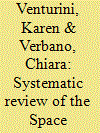

|
|
|
|
|
| Publication |
2014.
|
| Summary/Abstract |
In order to justify high expenditure during this period of financial crisis, Space Agencies have attempted to increase the returns on their investments in Space missions by encouraging the commercial use of advanced technologies. The development of a technology transfer process from Space to Earth not only benefits the Aerospace industry but also the network of national companies. Technology transfer has been shown to stimulate innovation in business and commerce, support economic growth and provide a return on public investment in research and development (R&D). The aim of this paper is to systematically review the Space technology transfer literature and to suggest directions for future research. The range of research and studies in the literature on this topic requires a systematic review to summarize the results in an unbiased and balanced manner and to interpret these in a way that highlights the research gaps. This article presents an overview of the dominant thinking (explicit in selected articles from 1995 to present), indicating the problems of analysis, research gaps and a future research program.
|
|
|
|
|
|
|
|
|
|
|
|
|
|
|
|
| 6 |
ID:
096164


|
|
|
|
|
| Publication |
2010.
|
| Summary/Abstract |
Canada is a space power with unique technical niches that support opportunities for collaboration on space technologies. When U.S.-origin space technologies are involved Canada's ability to collaborate internationally may be conditional on US law and policy. As a result, US export control law can be directly linked to the success or failure of Canadian collaboration. This article examines the strategic impact of U.S. export controls on Canadian autonomy to collaborate on international missions, including multi-use missions. Canadian space export control policy is also examined more broadly with the goal of providing specific policy recommendations that will enhance Canada's future as an international space actor.
|
|
|
|
|
|
|
|
|
|
|
|
|
|
|
|
|
|
|
|
|